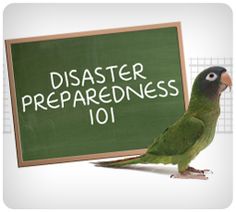
Hurricane season started in June. Many have pets so creating a plan to keep our loved pets is a must. Hurricanes, like floods, brushfires, and tornadoes, can be frightening things to be caught in (and these tips can be applied to those natural disasters, too). Planning can make the storm easier and safer for you and your pet.
Make a Plan
Simply put, be prepared. Decide on a course of action and make sure you can initiate it at a moment’s notice. Have supplies set aside in a safe, easily accessible place. It’s like having candles or a flashlight under the kitchen sink in case of a black out. You may never need them, but if a blackout happens, there’s no need to scramble in the dark, because you know exactly where to go and what to do for light.
Rescue Alert Sticker
This easy-to-use sticker will let people know that pets are inside your home. Make sure it is visible to rescue workers (we recommend placing it on or near your front door), and that it includes the types and number of pets in your home as well as the name and number of your veterinarian. If you must evacuate with your pets, and if time allows, write “EVACUATED” across the stickers. To get a free emergency pet alert sticker for your home, please fill out the ASPCA’s online order form and allow 6-8 weeks for delivery. Your local pet supply store may also sell similar stickers. You can also create your own sign and tape it in an obvious area (ex- front window).
Staying In
If you’re staying home to ride out the storm, keep your pet in its carrier or on a leash. You never know when you might be forced to evacuate. And even if that doesn’t happen, you don’t want to be tracking down a petrified pet during the chaos. Therefore, secure your pet before the storm hits.
Going Out
Stay tuned to the news reports. If you’re told to evacuate, you must do so at first warning. Moreover, it helps to have everything ready to go. We suggest a backpack that holds all the essentials for you and your pet. And make sure you know ahead of time exactly where all the shelters are and how to get there.
Prepare Emergency Supplies and Traveling Kits
If you must evacuate your home in a crisis, plan for the worst-case scenario. Even if you think you may be gone for only a day, assume that you may not be allowed to return for several weeks. When recommendations for evacuation have been announced, follow the instructions of local and state officials. To minimize evacuation time, take these simple steps:
- Make sure all pets wear collars and tags with up-to-date identification information. Your pet’s ID tag should contain his name, telephone number and any urgent medical needs. Be sure to also write your pet’s name, your name and contact information on your pet’s carrier.
- The ASPCA recommends microchipping your pet as a more permanent form of identification. A microchip is implanted under the skin in the animal’s shoulder area, and can be read by a scanner at most animal shelters.
- Always bring pets indoors at the first sign or warning of a storm or disaster. Pets can become disoriented and wander away from home in a crisis.
- Store an emergency kit and leashes as close to an exit as possible. Make sure that everyone in the family knows where it is, and that it clearly labeled and easy to carry. Items to consider keeping in or near your “Evac-Pack” include:
- Pet first-aid kit and guide book (ask your vet what to include)
- 3-7 days’ worth of canned (pop-top) or dry food (be sure to rotate every two months)
- Disposable litter trays (aluminum roasting pans are perfect)
- Litter or paper toweling
- Liquid dish soap and disinfectant
- Disposable garbage bags for clean-up
- Pet feeding dishes and water bowls
- Extra collar or harness as well as an extra leash
- Photocopies and/or USB of medical records and a waterproof container with a two-week supply of any medicine your pet requires (Remember, food and medications need to be rotated out of your emergency kit—otherwise they may go bad or become useless)
- At least seven days’ worth of bottled water for each person and pet (store in a cool, dry place and replace every two months)
- A traveling bag, crate or sturdy carrier, ideally one for each pet
- Flashlight
- Blanket
- Recent photos of your pets (in case you are separated and need to make “Lost” posters)
- Especially for cats: Pillowcase, toys, scoop-able litter
- Especially for dogs: Extra leash, toys and chew toys, a week’s worth of cage liner
Stay Calm
Whether you leave early, choose to stay, or are required to evacuate due to the storm’s severity or due to house damage, remember to stay calm. Your pet can sense your emotions, so a calming demeanor can lead to a less-panicked pet. Oh, and don’t forget to speak to your pet in a calm, soothing voice, too.
**adapted from PetMD and ASPCA**
2,049 total views, 1 views today
